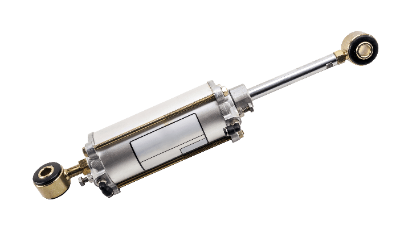What Is a Cylinder?
 A cylinder is a device that amplifies and converts supplied pressure into propulsive force. Air or oil is used as the pressure source in a cylinder. A cylinder generates thrust through an internal structure based on Pascal’s principle.
A cylinder is a device that amplifies and converts supplied pressure into propulsive force. Air or oil is used as the pressure source in a cylinder. A cylinder generates thrust through an internal structure based on Pascal’s principle.
The thrust amplified by the cylinder is used for the linear reciprocating or rotary oscillating motion required in the drive units of production equipment. Pneumatic cylinders (air cylinders), which are driven by pneumatic pressure, are used in the automobile, semiconductor, and food industries.
Hydraulic cylinders, which use oil pressure as their drive source, are used in various fields such as construction machinery, heavy machinery, and press equipment.
Uses of Cylinders
Pneumatic cylinders are often used in production plants in the automotive, semiconductor, and food industries. The use of pneumatic cylinders makes it possible to easily and compactly achieve labor-saving and automation purposes, such as moving workpieces. For this reason, pneumatic cylinders are employed in a variety of automated equipment and are utilized in operations such as assembly and transfer.
When the pressure used in pneumatic cylinders is about 0.5 MPa, operations similar to human power, such as linear reciprocating motion and rotational oscillating motion, can be easily realized. Hydraulic cylinders, on the other hand, provide a far higher thrust force than pneumatic cylinders and are used in construction equipment, heavy machinery, and other situations where power is required.
Principle of Cylinders
Cylinders generate thrust using Pascal’s principle. Located on the side of the cylinder are the air and oil supply and exhaust ports, which allow air and oil to enter and exit the cylinders. The pressure supplied through the air supply and exhaust ports moves the piston and rod inside the cylinders back and forth using Pascal’s principle to generate thrust.
When the pressure supplied to the cylinder’s supply and exhaust ports is pneumatic, the thrust is at a small to medium level. When the pressure is hydraulic, the thrust is medium to high. The main components of cylinders are the cylinder tube, piston rod, and front and rear covers.
If we compare it to a syringe, the outer cylinder tube is the cylinder tube, and the piston rod is the part that moves back and forth inside the cylinders. The part that serves as the lid of the cylinders is the front and rear cover. With an air cylinder, a cushion is used in the cover section to absorb the shock when the cylinders are driven.
The packing is used around the circumference of the cylinder’s piston. The packing serves to maintain a tight seal between the cylinder side and the rod side while ensuring accurate movement. Damage to the packing can cause poor sliding properties of the cylinders. Therefore, packing is often treated as a maintenance part.
Types of Cylinders
The internal space of a cylinder is called the cylinder side (or tube side) and the rod side. The rod side is the one where the rod that drives the piston is inside the space. The other side, where there is nothing inside the space, is the cylinder’s side.
1. Double-Acting Cylinders
Double-acting cylinders are designed to extend and retract freely by filling both the cylinder side and the rod side with fluid (generally air or hydraulic pressure) and applying pressure. The piston rod moves back and forth by switching the air supply and exhaust at the air supply and exhaust ports.
2. Single-Acting Cylinders
Single-acting cylinders are driven by pressure fluctuations on one side only. The piston rod moves when pressure is applied to the air supply and exhaust ports, and the rod returns when pressure is exhausted from the air supply and exhaust ports.
How to Select Cylinders
When selecting cylinders, the stroke should be taken into consideration. The stroke of cylinders is the distance over which the cylinder extends and retracts.
The position at which the cylinders are fully extended and fully retracted is called the cylinder’s stroke end. In other words, the stroke end is the position at which the piston cannot move any further.
The maximum stroke distance is determined by the length of the cylinder tube and rod. However, this does not mean that the length can be increased without reproduction. If the diameter is small in relation to the length, machining becomes more difficult. In addition, the longer the length, the more difficult it is to maintain the roundness of the cylinders I.D. and piston O.D. Poor roundness will result in poor airtightness, and the cylinders will not be able to move accurately.
Furthermore, if the diameter is small in relation to the stroke, the cylinders may buckle under high loads during extension. Therefore, the stroke and diameter must be selected to suit the intended purpose.